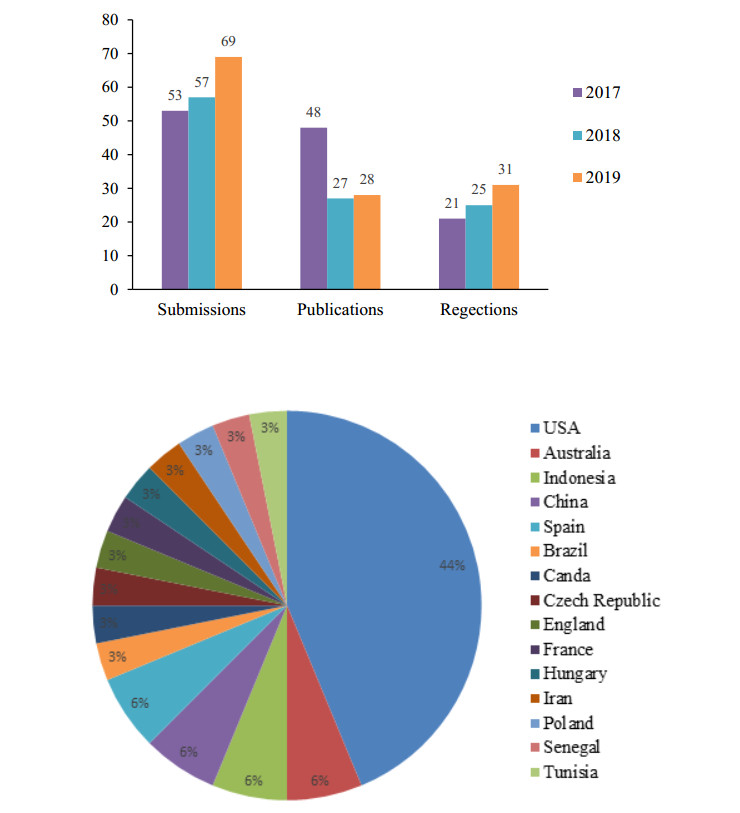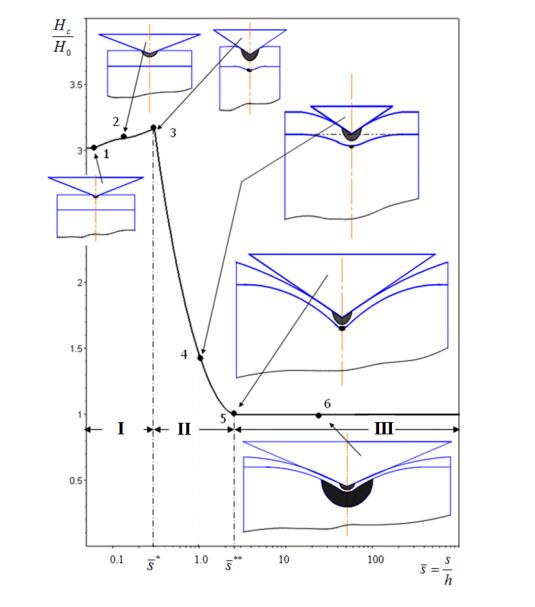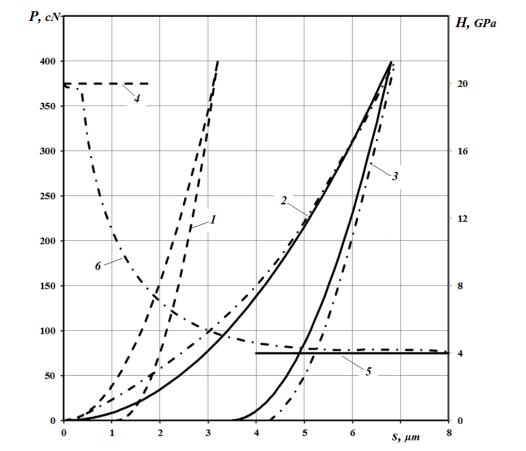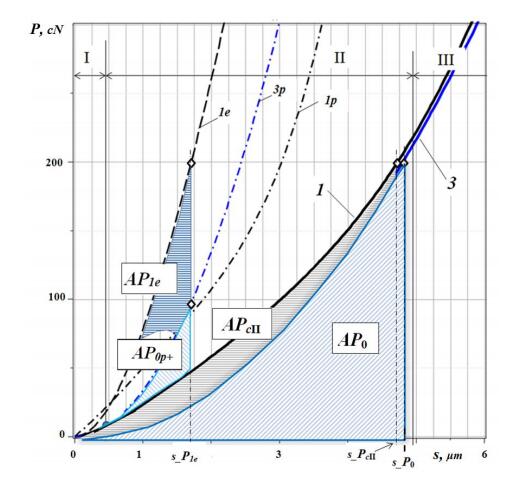The use of materials with a surface layered structure (solid bodies with a thin coating, so-called topocomposites) in friction units makes it possible to extend significantly the possibilities of tribologists in developing materials with a required set of tribological characteristics. The main mechanical characteristics of the materials of friction pairs are presented by the elastic modulus and hardness (microhardness). For topocomposites, these characteristics depending on the thickness of the coating are variable. They vary more significantly, the greater the difference between the mechanical characteristics of the components (coating, substrate) composing the layered material. Modern procedures of the standard experimental determination of the hardness of a surface covered with a protective coating involve depth-sensing indentation. In this study, a theoretical description of the indentation load-displacement curves for materials with a surface coating or a hardened surface layer has been obtained. The analysis of the deformation process taking into account the topocomposite structure of the surface is carried out. The phenomenon of additional plastic deformation of the base material of the topocomposite is established.
Citation: Nikolay A. Voronin. Analysis of the mechanisms of deformation of topocomposites by modeling of the indentation load-displacement curves[J]. AIMS Materials Science, 2019, 6(3): 397-405. doi: 10.3934/matersci.2019.3.397
Related Papers:
| [1] |
Yifeng Wang .
Journal summary from Editor in Chief. AIMS Environmental Science, 2024, 11(3): 380-380.
doi: 10.3934/environsci.2024018
|
| [2] |
Yifeng Wang .
Journal summary from Editor in Chief. AIMS Environmental Science, 2025, 12(2): 252-252.
doi: 10.3934/environsci.2025011
|
| [3] |
Yifeng Wang .
Journal summary from Editor in Chief. AIMS Environmental Science, 2021, 8(2): 100-100.
doi: 10.3934/environsci.2021007
|
| [4] |
Yifeng Wang .
Journal summary from Editor in Chief. AIMS Environmental Science, 2022, 9(2): 217-217.
doi: 10.3934/environsci.2022014
|
| [5] |
Yifeng Wang .
Journal summary from Editor in Chief. AIMS Environmental Science, 2023, 10(2): 245-245.
doi: 10.3934/environsci.2023014
|
| [6] |
Yifeng Wang .
Journal summary from Editor in Chief. AIMS Environmental Science, 2018, 5(1): 64-66.
doi: 10.3934/environsci.2018.1.64
|
| [7] |
Yifeng Wang .
Journal summary from Editor in Chief. AIMS Environmental Science, 2016, 3(1): 140-140.
doi: 10.3934/environsci.2016.1.140
|
| [8] |
Yifeng Wang .
Journal summary from Editor in Chief. AIMS Environmental Science, 2019, 6(4): 262-264.
doi: 10.3934/environsci.2019.4.262
|
| [9] |
Yifeng Wang .
Journal summary from Editor in Chief. AIMS Environmental Science, 2017, 4(2): 287-288.
doi: 10.3934/environsci.2017.2.287
|
| [10] |
Rukhsana Kokkadan, Resha Neznin, Praseeja Cheruparambath, Jerisa Cabilao, Salma Albouchi .
A Study of Infaunal Abundance, Diversity and Distribution in Chettuva Mangrove, Kerala, India. AIMS Environmental Science, 2023, 10(1): 82-92.
doi: 10.3934/environsci.2023005
|
Abstract
The use of materials with a surface layered structure (solid bodies with a thin coating, so-called topocomposites) in friction units makes it possible to extend significantly the possibilities of tribologists in developing materials with a required set of tribological characteristics. The main mechanical characteristics of the materials of friction pairs are presented by the elastic modulus and hardness (microhardness). For topocomposites, these characteristics depending on the thickness of the coating are variable. They vary more significantly, the greater the difference between the mechanical characteristics of the components (coating, substrate) composing the layered material. Modern procedures of the standard experimental determination of the hardness of a surface covered with a protective coating involve depth-sensing indentation. In this study, a theoretical description of the indentation load-displacement curves for materials with a surface coating or a hardened surface layer has been obtained. The analysis of the deformation process taking into account the topocomposite structure of the surface is carried out. The phenomenon of additional plastic deformation of the base material of the topocomposite is established.
Dear Editorial Board Members,
It is my pleasure to share with you the year-end report for AIMS Environmental Science. The journal continues to improve its quality as indicated by steady increases in the number of manuscripts received and the number of articles published over the past three years (Figure 1). We have received 69 submissions with 28 published online. The most downloaded and cited papers are listed in Tables 1 and 2. The top read article received more than 11390 downloads.
I would like to thank all the board members for serving on the Editorial Board and their dedication and contribution to the journal, especially to the editors for two special issues: Impacts of Microplastics in the Urban Environment Conference and Green built environment. The goal in 2020 is to solicit more manuscripts and increase paper citations. We will try our best to reduce the processing time and supply with a better experience for publication. To recognize the contribution of the Editorial Board members and authors during the years, we will continue to offer that (1) for authors invited, the article processing charge (APC) is automatically waived; (2) each editorial board member is entitled for some waivers. I am looking forward to continuing working with you to make the AIMS Environmental Science a sustainable and impactful journal. Please don’t hesitate to send me e-mails if you have new ideas and suggestions to help us to achieve this goal.

Yifeng Wang, Ph.D.
Editor in Chief, AIMS Environmental Science
References
|
[1]
|
ISO 14577-1: 2015 (2015) Metalling materials-Instrumented indentation test for hardness and materials parameters. Part 1. Test method.
|
|
[2]
|
Fischer-Cripps AC (2008) Nanoindentation, New York: Springer.
|
|
[3]
|
Fischer-Cripps AC (2006) Critical review of analysis and interpretation of nanoindentation test data. Surf Coat Tech 200: 4153–4165. doi: 10.1016/j.surfcoat.2005.03.018

|
|
[4]
|
Argatov II, Sabina FJ (2013) Asymptotic analysis of the substrate effect for an arbitrary indenter. Q J Mech Appl Math 66: 75–95. doi: 10.1093/qjmam/hbs020

|
|
[5]
|
Argatov II, Sabina FJ (2014) Small-scale indentation of an elastic coated half-space: influence of poisson's ratios on the substrate effect. Int J Eng Sci 81: 33–40. doi: 10.1016/j.ijengsci.2014.04.001

|
|
[6]
|
Argatov II, Sabina FJ (2016) Small-scale indentation of an elastic coated half-space: the effect of compliant substrate. Int J Eng Sci 104: 87–96. doi: 10.1016/j.ijengsci.2016.04.008

|
|
[7]
|
Aisikovish SM, Alexsandrov VM, Krenev LI, et al. (2006) Contact problems of elastic theory for non-homogeneous medium, Moscow, RF: Fismatlit (in Russian).
|
|
[8]
|
Voronin NA (2002) Calculation of the parameters of the elastic contact and effective characteristics of a topocomposite for the case of its contact with a spherical indentor. Frict Wear 23: 583–596.
|
|
[9]
|
Voronin NA (2012) Composite and real hardness of thin coatings. Adv Mater Res 560–561: 803–808.
|
|
[10]
|
Ngo CC (2015) Investigation of outside contact deformation under the local loading. Vestn Nauki Obrazov Sev-Zap Rossii 1: 1–8 (in Russian). Available from: http://vestnik-nauki.ru/.
|










 DownLoad:
DownLoad:







